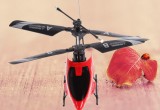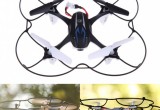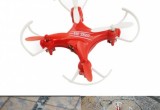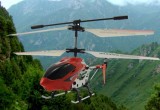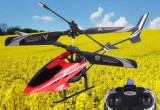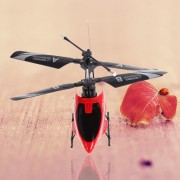
Good intermediate R/C helicopter requires Good quality, medium sized single rotor collective pitch R/C helicopter. These birds strike the best balance between maneuverability, performance, ease of use, and price.
shenzhen, China, October 16, 2015 (Newswire.com) - The R/C Helicopter hobby has seen a huge resurgence in popularity lately due to the fact that current technology has made them easier to fly than ever and at the same time, reduced the price significantly. It also happens to be one of the most fun and exciting ways to spend leisure time whether one is solo or with the family. Many people begin their journey into R/C flying by purchasing an inexpensive fixed pitch rotor heli to learn with. This is a smart move, fixed pitch helis are simple, easy to fly, and in case of the inevitable crash, easy to repair. All things that are important when starting out in the R/C world. Other people actually go one step further to reduce the learning curve and begin with a quad copter. These muti-rotor flyers, are mechanically very simple yet include sophisticated electronics to stabilize their flight, making them perfect for beginners. Either way, it doesn’t take long to learn basic flight maneuvers and R/C control. Sooner or later, everyone wants to take their hobby and their flight skills to the next level. So, the question becomes… What features make a good intermediate level R/C helicopter?
It’s a very simple question with a lot of different answers, there are so many types of helicopter styles to choose from and all of them have their strengths and weaknesses. However, a general consensus for moving from beginner to intermediate is that the student should graduate to a good quality, medium sized single rotor collective pitch R/C helicopter. These birds strike the best balance between maneuverability, performance, ease of use, and price.
First, it’s important to choose a helicopter that is an appropriate size. Most folks learn with a very small helicopter or RC Quadcopter, but in order to improve flying and performance, an intermediate helicopter should by medium size or above (6-12 inch rotor). Larger helicopters will be more powerful, have greater battery capacity, and handle wind better, making them great for the outdoors and for learning new maneuvers. Also, especially for outdoor flight, the medium sized helis will have greater range and their relatively large size makes them easy to see from far away, a great benefit for new flyers!
The next thing to consider is the rotorpitch method, which determines how the rotor of the heli affects movement and control. Moving from beginner to intermediate usually means going from a simple fixed pitch (non-adjustable rotor angle to facilitate ascent and descent) to a collective pitch rotor which is adjustable while in flight for greater responsiveness and control. The downside of collective pitch rotors are that they require more experience and skill to control but for people learning, they can be setup for easier flight while skill level increases.
It’s also good to select a heli with a collective pitched tail rotor. Like the main rotor, these tail rotors can make fine adjustments for greater responsiveness and stability when flying a new, larger, more powerful heli.
Another important consideration is thinking about repair parts, availability, and price. Chances are, as students of flight progress to more complex maneuvers and more hours of outdoor flight, some small crashes will occur. Most brand name helis have lots of parts availability and they are easy to fix, a very important benefit to the on-going cost of the hobby.
Finally, consider the number of control channels for a good intermediate RC helicopter.
RC helicopters use radio signals to control flight movements and each movement requires a different signal. 2 and 3 channel helis are good to start learning on and for indoor flying but they are limited by the maneuvers they can accomplish. 4 and 6 channel helismake the best balance between ease of use and maneuverability are a recommended choice whenchoosing a good intermediate R/C helicopter.
For most people, buying their first R/C Helicopter is just the beginning. It’s a fun hobby that can grow with a person’s skill level. When it’s time to move up to a good intermediate RC helicopter, it’s best to choose a high quality, medium sized, 4 or 6 channel helicopter with collective pitch rotor control. This type of heli will offer new intermediates the best of all worlds for fun, performance, and price and will offer the ability to improve on skill and fun in the exciting world of R/C flying.
Share:
